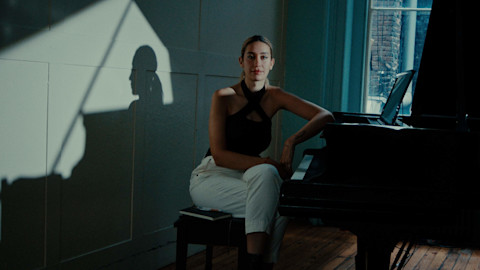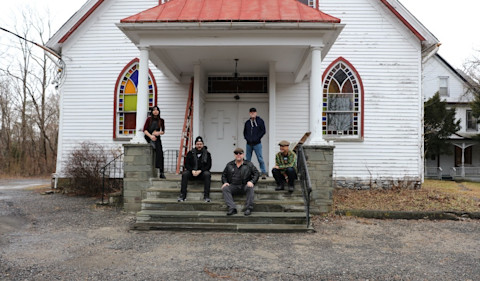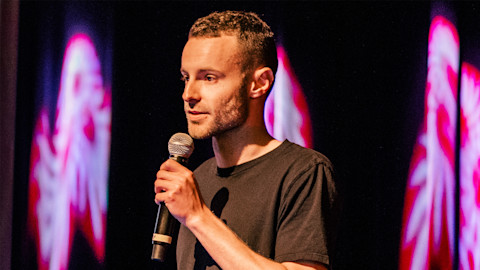The producer and songwriter's signature sound comes from a mix of analog and digital gear.
Ryan DeRobertis—best known to fans as Skylar Spence—started his home-recording career when he was in eighth grade. "I was making joke records with my friends, but I got really intense about them," the Long Island native recalls. "We were just plugging the microphone that came with Rock Band into a laptop's USB port. I didn't even have a keyboard that had any MIDI capabilities so I used the musical typing for four years, until I could invest in an actual keyboard."
The 27-year-old, Brooklyn-based musician has come a long way since then, touring the world with artists like Anamanaguchi and Madeon, headlining two installments of the 100% Electronicon festival, working on the vaporwave project Saint Pepsi, and releasing the acclaimed 2015 album Prom King as Skylar Spence. "I've gone from doing this in the crudest, most amateur way to resembling a professional musician," he laughs.
And he's done pretty much all of it—including the Prom King follow-up, which he's working on now—from his home studio. "I've only ever really recorded from home," notes DeRobertis. "The computer I'm using is a 27-inch 2019 iMac that I got last summer. It's the best investment that I've probably made in music because Ableton runs whether I'm working with four tracks or 32.
"My headphones are Sennheiser HD 6XX's that were a collaboration between Sennheiser and this site called Massdrop," he continues. Based on Sennheiser's industry-standard HD 650s, these open-back models allow air to pass through them to give the user the 360-degree experience of being in the physical space where a track was recorded, as opposed to just the standard left-right mix you’d get with closed-back headphones or earbuds. “It's like a less-gimmicky, less-pronounced version of those videos of ‘3D audio where [the sounds are] going around your head, the binaural kind of stuff," he notes, while also mentioning that if you’re using these in public, everyone else can hear what you’re listening to too.
The key to Spence’s retro-future dance jams, though, are jittery guitars, winsome vocals, and lush synths. "Right now, I'm playing a Fender Stratocaster and sometimes I'll play a Danelectro DC-3 that I bought on tour with Madeon in 2016," DeRobertis says of his go-to axes. For the low end, DeRobertis uses what he calls a "Frankenbass" that was commissioned by Skylar Spence's bassist Scott Interrante. "I think it's got a Fender body and the neck is from a Japanese company," says DeRobertis. "He let me borrow it to record recently and, when we were on tour, he started using that bass, too."
DeRobertis tracks his vocals on a Shure PG58 and a Zoom H4N, and summons his synths with a full-size Arturia Keylab 49 that uses Virtual Studio Technology (VST) modeling to bring sounds from the past to life. "The Keylab doesn't have any sounds on its own—no presets or anything," he notes. "I'll plug it into the computer and use it as a controller for anything from a drum rack to '80s synths like the Prophet or the Korg MS. I have a lot of Arturia plugins and they come up with emulations of anything from the Clavinet to the Fairlight to the DX. If I want something to sound like a Human League record, I'll use the Arturia.”
While DeRobertis relies on the Spectrasonics Omnisphere, with its 80-gigabyte bank and algorithmic synth variations, to create a combination of sounds, he’s also exploring new auditority depths with a classic, early ‘00s synth. "I've been using a Korg microKORG, which is a hand-me-down from my friend who's a synth collector. He's been quarantining in Vermont, so he let me borrow that so I could do some hard synth stuff," he says.
"For guitar, I record clean-direct into my interface," he says. "The Radial J48 uses phantom power to work around the current of whatever the limitations of the interface would be. It's powering my guitar to give the interface the levels it needs for a Nile Rodgers kind of tone, something that's not affected by amplifier modeling or anything like that.” He also emulates Rodgers’ use of reverb through an Altiverb or a Lexicon. “They do algorithms for different types of rooms—a chamber, a concert hall. Depending on what space I want it to occupy, my mileage will vary. And then I compress the hell out of it, because having things really attack-y in the mix is sort of my sound signature."
For delay, DeRobertis also uses Soundtoys' EchoBoy plug-in. “It models different types of delay—anything from the Memory Boy [delay pedal] to cheap tape to a studio echo. I use that for vocals and synths. It's a very versatile VST."
DeRobertis connects all this gear to his computer using Focusrite Scarlett 2i2 or Universal Audio Arrow interfaces, then puts his songs together with Ableton. "I've used GarageBand, Logic, and Reason through the years, but Ableton is where I feel most comfortable," he says. "I do a lot of sample-based work, and the great thing about Ableton is you can throw in a song that's already made and it tries its hardest to make the song make sense in whatever tempo, beats per minute, and time signature that you have in your session.”
"I couldn't do what I am currently doing without my Strat and the Ableton Push, which is Ableton's version of the MPD from Akai or the APC40," he says. "[The Push] takes out a lot of the pointing and clicking that comes with using a computer to do the majority of this because you can just press a button."
Mixing analog and digital, old and new, and factory-built and homemade all helps DeRobertis craft Skylar Spence's sound, which is complex enough to intrigue the most studious musicians while also being immediate enough to inspire dancing in the masses. "I want something where you can't really tell what was recorded and what was made through Ableton," he says. "You're asking, 'What is software? What is hardware?' when you hear it. In my experience, that comes from balancing fake, pristine-sounding synths with real-sounding sampled synths."
—Maura Johnston
Popular Stories
video
How Julia Wolf Made It




